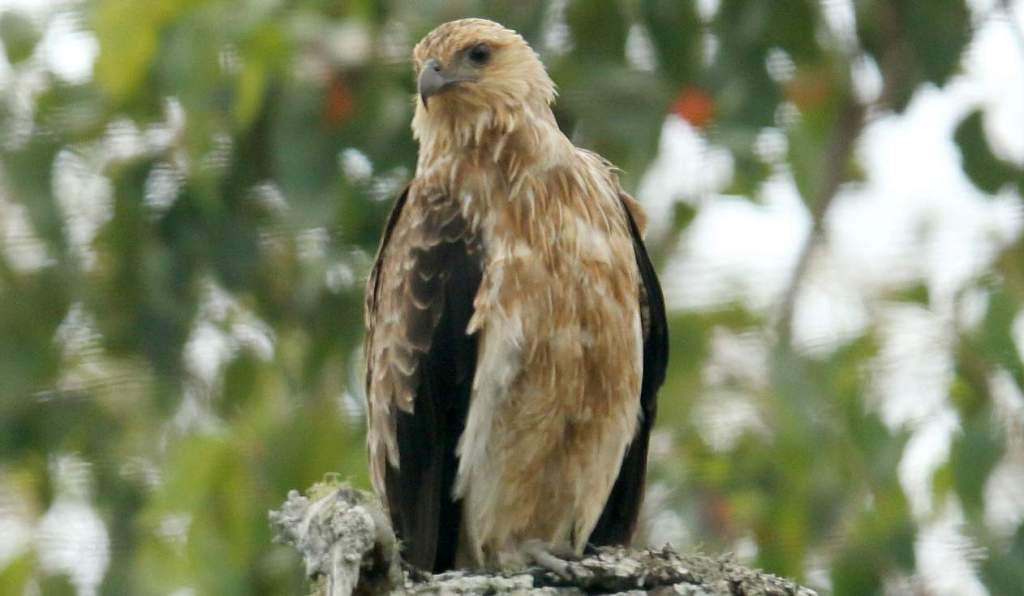The whistling kite (Haliastur sphenurus) glides slowly at low altitudes or soaring high into the sky. The Whistling Kite is, in fact, a graceful bird. When gliding their wings remain horizontal but are bowed downward at the tips while flapping with slow wingbeats. A whistling call is occasionally emitted during flight, but the tail is not twisted during maneuvers. It is also known as the Carrion Hawk or Whistling Eagle.
Whistling kites are common throughout Australia, but they prefer open wooded areas near swamps, rivers, and coasts, avoiding settlements and slaughter yards frequented by the Black Kite. Even though it tends to be sedentary, it shifts its location when prey is irrupting in the inland or when there is a famine. There is a communal aspect to it as well. Whistling kites usually gather in small groups on large kills, but they also forage alone; large, loose flocks of 100 or more are rare.
As with other kites, it sails around looking for living or dead prey on the ground, swooping down and eating it there if it is too large to be carried. However, it takes live animals such as small mammals, reptiles, birds, fish, crustaceans, and large insects. It is also a scavenger, eat carrion, including those killed by traffic on the road.
The Whistling Kite breeds opportunistically, sometimes courting in groups and tolerating each other’s nests in the same tree. The courtship birds soar about the nest tree without spectacular aerial maneuvers, but they call a lot, both from high, exposed perches and in flight. Year after year, or even twice a season, most pairs return to the same nest, made of sticks lined with green leaves, adding weight to it each time. Female kites incubate and brood while males hunt, and chicks receive all their food when they are young from their mothers. The Whistling Kite measures 500–550 mm long.
Both sexes are similar; females are larger. Head and neck are plain pale buff-brown with a little streaking. Back and upper wings covert mid-brown; flight feathers are dusky. The tail is pale grey-brown. Underparts are buff, faintly streaked brown. Underwings with buff-brown coverts and inner primaries form a bar between the outer primaries and secondaries. Eyes are brown. Bill and Cere are dusky brown. Feel whitish grey; claws dusky.
Read More: Brahminy Kite (Milvus Indus)
The immature bird is darker; the head, neck, and underparts are brown with strong streaks of buff; the back, shoulders, and upper-wing coverts are thickly spotted buff. Spots disappear, and the head becomes paler at the end of the first year. The downy young are buff-white and darker on the head and back. Whistling kite call consist of a long, shrill, down-slurred whistle followed by six rapid, ascending short notes
Nesting and breeding are apparently possible at any time of year in warm regions where food supply is abundant; in southeastern Australia, breeding occurs in the spring. Large nests of sticks, about 600–700 mm across, lined with fresh green leaves, 15 meters or more above ground, often in a dominating tree, usually by a river, The kite lays 2 or 3 eggs, rough-textured, pale white-blue, sparingly marked with red-brown blotches, and oval, about 57 x 44 mm. Incubation by the female Young fledges takes about six weeks.
An often-sighted bird, the Whistling Kite is usually found in open woodland near swamps, rivers, lakes, and the coast; it avoids dense forests and treeless deserts. It is also found in Papua New Guinea, the Solomon Islands, and New Caledonia. There is no race.
Read More: Square-tailed Kite (Lophoictinia isura)

